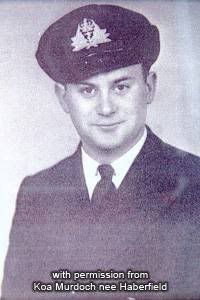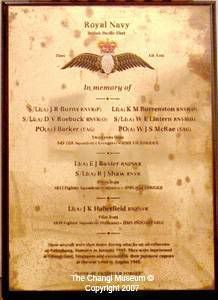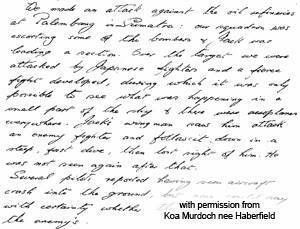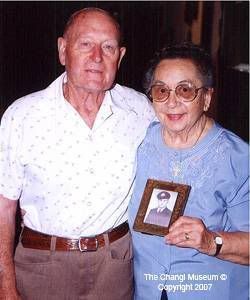Thursday, March 1, 2007
The 'Palembang Nine' was a group of nine men from the Royal Navy British Pacific Fleet. The men were either pilots or crew members of the HMS Victorious, the HMS Illustrious or the HMS Indomitable. The 'Palembang Nine' consisted of the following men:
Lt. John Haberfield (below)- Pilot from 1839 Fighter Squadron (HMS Indomitable)
Lt. Evan John Baxter - Pilot from 1833 Fighter Squadron (HMS Illustrious)
S/Lt. Reginald James Shaw - Pilot from 1833 Fighter Squadron (HMS Illustrious)
Lt. Kenneth Morgan Burrenston - Crew from 849 TBR Squadron (HMS Victorious)
S/Lt. John Robert Burns - Crew from 849 TBR Squadron (HMS Victorious)
S/Lt. Donald V Roebuck - Crew from 849 TBR Squadron (HMS Victorious)
S/Lt. William Edwin Lintern - Crew from 849 TBR Squadron (HMS Victorious)
Petty Officer Ivor Barker - Crew from 849 TBR Squadron (HMS Victorious)
Petty Officer J S McRae - Crew from 849 TBR Squadron (HMS Victorious)
Information above is based on the Royal Navy British Pacific Fleet Plaque (below), donated to the Changi Museum.

Lieutenant John Haberfield of the HMS Indomitable & The Royal Navy British Pacific Fleet Plaque
Haberfield, a New Zealander, had enlisted with the Fleet-Air-Arm in August 1941 at the age of 21. He left his home town for service overseas, where he piloted a range of planes, largely orchestrated for carrier-based raids. The last squadron he served was with the 1839 Squadron and the Pacific Fleet, where he piloted Hellcats from the HMS Indomitable.
Haberfield had gone missing during his last raid on Palembang, Sumatra on 24th January 1945. The following letter from the Commanding Officer of the 1839 Squadron, addressed to Haberfield's mother, accounts the incidents that led up to his disappearance:
"We made an attack against the oil refineries at Palembang in Sumatra: our squadron was escorting some of the bombers & Jack (Haberfield's nickname) was leading a section. Over the target we were attacked by Japanese fighters and a fierce fight developed, during which it was on possible to see what was happening in a small part of the sky & there were aeroplanes everywhere. Jack's wingman saw him attack an enemy fighter and followed it down in a steep, fast dive, then lost sight of him. He was not seen again after that. Several pilots reported having seen aircraft crash into the ground, but none could say with certainty whether they were our own or the enemy's."
1839 Squadron
The oil refineries in Palembang was a critical source of oil for the Japanese, which became the reason why the Fleet had targeted Palembang. Unfortunately the raid was at the expense of the nine men who, like Haberfield, had gone missing.
The whereabouts of the nine men had remained unknown throughout the war. It was only after the war ended, that British authorities began to investigate the disappearance of the men in 1946.
Investigations began in Palembang; where the men were last seen. It was discovered that the men were kept prisoners in Palembang Prison until February 1945, when they were transferred to Singapore and housed in Outram Gaol.
In Singapore, Japanese Major Kataoka Toshio informed British investigating officials that the men had been shipped to Japan for interrogations but never made it as the ships were attacked and sunk by Allied bombings in March 1945. The investigating officer believed that he was telling the truth but it was revealed later by General Atauka, Chief of the Juridical Department for the 7th Army, that the nine men were illegally executed after the war on 15th August 1945.
Upon discovering this, investigating officials were prepared to arrest Major Toshio and Captain Okeda (the officials responsible for the men's execution). However before that could have been done, both men committed suicide. The following was written by Major Toshio before he committed suicide:
The museum has been in touch with John Haberfield's sister, Koa Murdoch since June 2002. Murdoch had been generous enough to donate a memorial plaque of her brother to the museum along with several other vital documents, documenting the events leading up to her brother's death.
Koa Murdoch with her late husband in 2002
The identities of the other eight men was never properly investigated.
Recent information suggests that some of the mentioned eight men were not even shipped to Singapore. One of the men was reported to have been seen in Tokyo in April 1945, while some of the other men were reportedly executed shortly after the raids and not executed in Singapore. Hence they were not part of the Palembang Nine.
Also, strong evidence suggests that over 30 Fleet Air-Arm aircrew were executed during captivity, than just the 'Palembang Nine'.
To the museum's knowledge, sufficient documentation is able to conclude that Haberfield was one of the 'Palembang Nine'. However, the identities of the other eight men who were shipped to Singapore with Haberfield, cannot be confirmed due to insufficient and conflicting information.
The Changi Museum extends their thanks to Koa Murdoch for sharing various documents, materials and photographs of her late brother and assisting in preserving the memory of him.
________________________________________________________________